Kevps
On this page, you find all documents, package deals, and flashcards offered by seller kevPS.
- 57
- 3
- 4
Community
- Followers
- Following
62 items
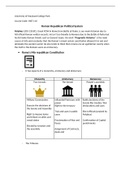
Understanding The Roman Republic's Constitution and Political System - HIST110 Ancient World Notes
The notes cover how the roman republic's political system works, the social environment of the Roman people, and its decline. It includes diagrams and tables to assist in understanding the system visually. It helps with understanding how the Roman republic's political system was a mixed political system with elements of a monarchy, aristocracy, and democracy
- Class notes
- • 4 pages •
The notes cover how the roman republic's political system works, the social environment of the Roman people, and its decline. It includes diagrams and tables to assist in understanding the system visually. It helps with understanding how the Roman republic's political system was a mixed political system with elements of a monarchy, aristocracy, and democracy
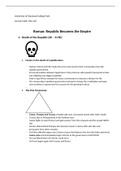
Roman Republic Into The Roman Empire (Principate) - HIST 110 The Ancient World History Notes
The notes cover how the roman republic ruled by the consuls and the senate, turned into imperial Rome ruled by emperors. First, it covers how the Marian reforms and sulla's reign have weakened the republic's political system. It covers the first and second triumvirate that gradually weakened the republic's political system. It briefly covers characters such as Julius Caesar, Pompey, Octavian, Mark Antony, and Crassus. It ends with a brief overview of how Emperor Augustus (Octavian) made reforms ...
- Class notes
- • 5 pages •
The notes cover how the roman republic ruled by the consuls and the senate, turned into imperial Rome ruled by emperors. First, it covers how the Marian reforms and sulla's reign have weakened the republic's political system. It covers the first and second triumvirate that gradually weakened the republic's political system. It briefly covers characters such as Julius Caesar, Pompey, Octavian, Mark Antony, and Crassus. It ends with a brief overview of how Emperor Augustus (Octavian) made reforms ...
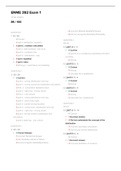
Old Midterm 1 Fall 2017 - Statistical Methods for Product and Processes Development
This is an old midterm from fall 2017 for the course, Statistical Methods for Product and Processes Development. The exam covered probability, Poisson's ratio, reliability, failure, combination, hypergeometric probability, and binomial distribution.
- Exam (elaborations)
- • 6 pages •
This is an old midterm from fall 2017 for the course, Statistical Methods for Product and Processes Development. The exam covered probability, Poisson's ratio, reliability, failure, combination, hypergeometric probability, and binomial distribution.
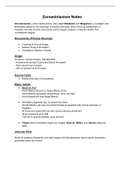
Zoroastrianism Persian Religion - AP History Notes
This set of class notes covered the Achaemenid Persian state religion called Zoroastrianism. It covers its sacred text, its origins, and its history in the Persian Empire. This also includes how its beliefs became the roots of Christianity, Judaism, and Islam.
- Interview
- • 2 pages •
This set of class notes covered the Achaemenid Persian state religion called Zoroastrianism. It covers its sacred text, its origins, and its history in the Persian Empire. This also includes how its beliefs became the roots of Christianity, Judaism, and Islam.
Midterm Vocabulary/Terms For History of the Crusades and Medieval Europe
- Flashcards
- • 14 items •
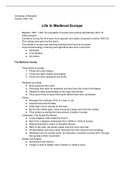
Life And Society In Medieval Europe - History of Medieval Europe And The Crusades Notes
The notes cover life in medieval Europe, the social class system, and the emergence of the university. It provides a brief context of the European society of the time such as the three classes; the clergy, the nobles, and the peasants. It briefly explains each class's duties and how they operated. It ends with a brief explanation of the birth of the University as an educational institution.
- Class notes
- • 2 pages •
The notes cover life in medieval Europe, the social class system, and the emergence of the university. It provides a brief context of the European society of the time such as the three classes; the clergy, the nobles, and the peasants. It briefly explains each class's duties and how they operated. It ends with a brief explanation of the birth of the University as an educational institution.
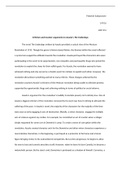
HIST 251 Paper/Essay - Azuela's Underdog and The Mexican Revolution
This essay connects the theme presented in Azuela's Novel, Underdog, to the themes and facts of the Mexican revolution in the early 20th century. The main argument of the essay is creating a counter-argument to the views and themes presented in the novel using facts from the revolution. It explores how the novel conveys its perspective on the revolution through literary techniques. This is followed by a counter-argument to Azula's novel's portrayal of the revolution with historical evidence a...
- Essay
- • 4 pages •
This essay connects the theme presented in Azuela's Novel, Underdog, to the themes and facts of the Mexican revolution in the early 20th century. The main argument of the essay is creating a counter-argument to the views and themes presented in the novel using facts from the revolution. It explores how the novel conveys its perspective on the revolution through literary techniques. This is followed by a counter-argument to Azula's novel's portrayal of the revolution with historical evidence a...
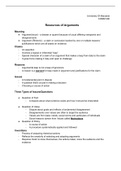
Resources of Arguments - COMM 200 Critical Thinking And Speaking Notes
The notes focus on the meaning and concepts of forming a rhetorical and literary argument. It explores types of issues/questions and types of arguments. Th e three types of issues/questions; fact, value, and policy. The reasoning types of arguments included are; enthymemes, induction, casual, and analogy.
- Class notes
- • 2 pages •
The notes focus on the meaning and concepts of forming a rhetorical and literary argument. It explores types of issues/questions and types of arguments. Th e three types of issues/questions; fact, value, and policy. The reasoning types of arguments included are; enthymemes, induction, casual, and analogy.

Chapter 6 Resources of Organization - COMM 200 Critical Thinking And Speaking Notes
The notes focus on the structure of an argument or any essays written such as the thesis, body of the speech, and conclusion. It explores the three types of rhetorical speech organizations; sequence, topical and logical structures. It ends with guiding questions to aid in writing up an effective introduction or conclusion.
- Class notes
- • 2 pages •
The notes focus on the structure of an argument or any essays written such as the thesis, body of the speech, and conclusion. It explores the three types of rhetorical speech organizations; sequence, topical and logical structures. It ends with guiding questions to aid in writing up an effective introduction or conclusion.
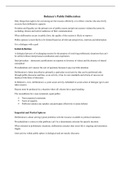
Bohmen's Public Deliberation And Birdsell's Visual Argument - COMM 200 Critical Thinking & Speaking Notes
The notes focus on Bohman's Public Deliberation and Birdsell's Visual argument concepts. Within Bohman's Public Deliberation section, the partial & impartial sphere, and discourse & dialogue concepts are explored. Birdsell's visual argument section provides brief summary of its definition and concepts.
- Class notes
- • 3 pages •
The notes focus on Bohman's Public Deliberation and Birdsell's Visual argument concepts. Within Bohman's Public Deliberation section, the partial & impartial sphere, and discourse & dialogue concepts are explored. Birdsell's visual argument section provides brief summary of its definition and concepts.
